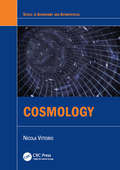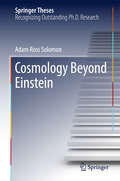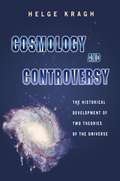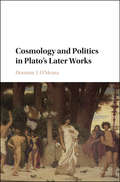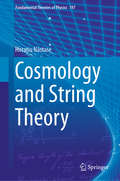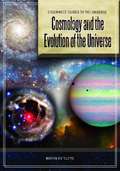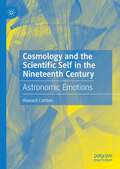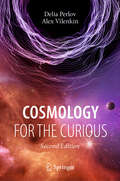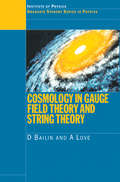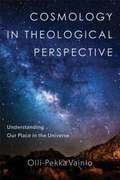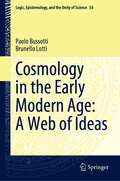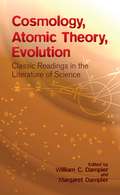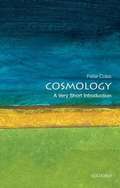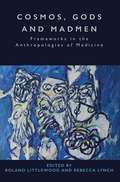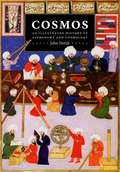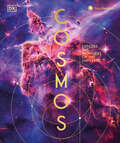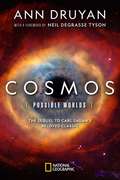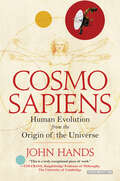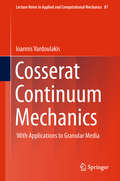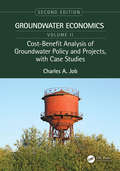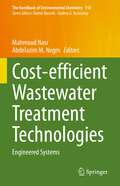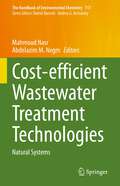- Table View
- List View
Cosmology (Series in Astronomy and Astrophysics)
by Nicola VittorioModern cosmology has changed significantly over the years, from the discovery to the precision measurement era. The data now available provide a wealth of information, mostly consistent with a model where dark matter and dark energy are in a rough proportion of 3:7. The time is right for a fresh new textbook which captures the state-of-the art in cosmology. Written by one of the world's leading cosmologists, this brand new, thoroughly class-tested textbook provides graduate and undergraduate students with coverage of the very latest developments and experimental results in the field. Prof. Nicola Vittorio shows what is meant by precision cosmology, from both theoretical and observational perspectives. This book is divided into three main parts: Part I provides a pedagogical, but rigorous, general relativity-based discussion of cosmological models, showing the evidence for dark energy, the constraints from primordial nucleosynthesis and the need for inflation Part II introduces density fluctuations and their statistical description, discussing different theoretical scenarios, such as CDM, as well as observations Part III introduces the general relativity approach to structure formation and discusses the physics behind the CMB temperature and polarization pattern of the microwave sky Carefully adapted from the course taught by Prof. Vittorio at the University of Rome Tor Vergata, this book will be an ideal companion for advanced students undertaking a course in cosmology. Features: Incorporates the latest experimental results, at a time of rapid change in this field, with balanced coverage of both theoretical and experimental perspectives Each chapter is accompanied by problems, with detailed solutions The basics of tensor calculus and GR are given in the appendices
Cosmology Beyond Einstein
by Adam Ross SolomonThis work investigates the theoretical and cosmological implications of modifying Einstein's theory of general relativity. It explores two classes of modifications to gravity: those in which the graviton is given a small mass, and those in which Lorentz invariance is spontaneously broken. It elucidates the nature of cosmological perturbations in theories of massive bimetric gravity, including a potentially deadly instability. Theories of gravity beyond general relativity could explain why the expansion of the Universe is accelerating, obviating the need for a dark energy, and can also affect the evolution of the early Universe. Next, it investigates the nature of spacetime in massive gravity theories that contain two different spacetime metrics. Lastly, the strongest constraints to date are placed on the size of Lorentz-violating effects in the gravity sector during inflation.
Cosmology and Controversy: The Historical Development of Two Theories of the Universe
by Helge KraghFor over three millennia, most people could understand the universe only in terms of myth, religion, and philosophy. Between 1920 and 1970, cosmology transformed into a branch of physics. With this remarkably rapid change came a theory that would finally lend empirical support to many long-held beliefs about the origins and development of the entire universe: the theory of the big bang. In this book, Helge Kragh presents the development of scientific cosmology for the first time as a historical event, one that embroiled many famous scientists in a controversy over the very notion of an evolving universe with a beginning in time. In rich detail he examines how the big-bang theory drew inspiration from and eventually triumphed over rival views, mainly the steady-state theory and its concept of a stationary universe of infinite age. In the 1920s, Alexander Friedmann and Georges Lemaître showed that Einstein's general relativity equations possessed solutions for a universe expanding in time. Kragh follows the story from here, showing how the big-bang theory evolved, from Edwin Hubble's observation that most galaxies are receding from us, to the discovery of the cosmic microwave background radiation. Sir Fred Hoyle proposed instead the steady-state theory, a model of dynamic equilibrium involving the continuous creation of matter throughout the universe. Although today it is generally accepted that the universe started some ten billion years ago in a big bang, many readers may not fully realize that this standard view owed much of its formation to the steady-state theory. By exploring the similarities and tensions between the theories, Kragh provides the reader with indispensable background for understanding much of today's commentary about our universe.
Cosmology and Politics in Plato’s Later Works
by O’meara Dominic J.Knowledge of the structure of the cosmos, Plato suggests, is important in organizing a human community which aims at happiness. This book investigates this theme in Plato's later works, the Timaeus, Statesman, and Laws. Dominic J. O'Meara proposes fresh readings of these texts, starting from the religious festivals and technical and artistic skills in the context of which Plato elaborates his cosmological and political theories, for example the Greek architect's use of models as applied by Plato in describing the making of the world. O'Meara gives an account of the model of which Plato's world is an image; of the mathematics used in producing the world; and of the relation between the cosmic model and the political science and legislation involved in designing a model state in the Laws. Non-specialist scholars and students will be able to access and profit from the book.
Cosmology and String Theory (Fundamental Theories of Physics #197)
by Horaţiu NăstaseCosmology describes the evolution of the Universe and is based on a description of its beginning from quantum fluctuations. String theory is the only known consistent theory of quantum gravity that can deal with the highest energy scales near the Planck energy, relevant for cosmology's beginning. As a result, only string theory can give a fully consistent picture of cosmological origins. This book describes the best current avenues for obtaining cosmology from string theory. It is aimed at graduate students, and also researchers, with some familiarity with cosmology and string theory, however no detailed knowledge is required.
Cosmology and the Early Universe (Series in Astronomy and Astrophysics)
by Pasquale Di BariThis book discusses cosmology from both an observational and a strong theoretical perspective. The first part focuses on gravitation, notably the expansion of the universe and determination of cosmological parameters, before moving onto the main emphasis of the book, the physics of the early universe, and the connections between cosmological models and particle physics. The book provides links with particle physics and with investigations of the theories beyond the Standard Model, especially in connection to dark matter and matter-antimatter asymmetry puzzles. Readers will gain a comprehensive account of cosmology and the latest observational results, without requiring prior knowledge of relativistic theories, making the text ideal for students. Features: Provides a self-contained discussion of modern cosmology results without requiring any prior knowledge of relativistic theories, enabling students to learn the first rudiments needed for a rigorous comprehension of cosmological concepts Contains a timely discussion of the latest cosmological results, including those from WMAP and the Planck satellite, and discuss the cosmological applications of the Nobel Prize 2017 awarded discovery of gravitational waves by the LIGO interferometer and the very high energy neutrinos discovered by the IceCube detector Includes original figures complementing mathematical derivations and accounting for the most important cosmological observations, in addition to a wide variety of problems with a full set of solutions discussed in detail in an accompanying solutions manual (available upon qualifying course adoption) To view the errata please visit the authors personal <a href=":http//www.southampton.ac.uk/~pdb1d08/">webpage.
Cosmology and the Evolution of the Universe
by Martin RatcliffeWritten with college students in mind, this reference offers a nonmathematical introduction to cosmology, designed to be accessible to nonspecialists. It begins with an overview of early ideas about the universe, from the ancient Egyptians to the modern era; the rest of book covers the 20th century and the early 21st century. Thematic chapters cover topics such as the large-scale structure of the universe, the discovery and importance of cosmic microwave background radiation, and the forces and particles involved in the evolution of the universe. Each chapter concludes with a list of print and electronic resources, and an annotated general bibliography at the end of the book lists general works or those of particular significance. Sidebars provide more in-depth information on key people and ideas without interrupting the flow of the main narrative. A glossary of scientific terms is included. The book's 66 b&w illustrations and images are more technical rather than awe-inspiring. Ratcliffe teaches cosmology at Wichita State University. Annotation c2009 Book News, Inc., Portland, OR (booknews.com)
Cosmology and the Scientific Self in the Nineteenth Century: Astronomic Emotions
by Howard CarltonThis book argues that while the historiography of the development of scientific ideas has for some time acknowledged the important influences of socio-cultural and material contexts, the significant impact of traumatic events, life threatening illnesses and other psychotropic stimuli on the development of scientific thought may not have been fully recognised. Howard Carlton examines the available primary sources which provide insight into the lives of a number of nineteenth-century astronomers, theologians and physicists to study the complex interactions within their ‘biocultural’ brain-body systems which drove parallel changes of perspective in theology, metaphysics, and cosmology. In doing so, he also explores three topics of great scientific interest during this period: the question of the possible existence of life on other planets; the deployment of the nebular hypothesis as a theory of cosmogony; and the religiously charged debates about the ages of the earth and sun. From this body of evidence we gain a greater understanding of the underlying phenomena which actuated intellectual developments in the past and which are still relevant to today’s knowledge-making processes.
Cosmology for Physicists (Series in Astronomy and Astrophysics)
by David LythWritten by an award-winning cosmologist, this brand new textbook provides advanced undergraduate and graduate students with coverage of the very latest developments in the observational science of cosmology. The book is separated into three parts; part I covers particle physics and general relativity, part II explores an account of the known history of the universe, and part III studies inflation. Full treatment of the origin of structure, scalar fields, the cosmic microwave background and the early universe are provided. Problems are included in the book with solutions provided in a separate solutions manual. More advanced extension material is offered in the Appendix, ensuring the book is fully accessible to students with a wide variety of background experience. Features: Incorporates the latest experimental results, at a time of rapid change in the field Explores the origin of structure and the Cosmic Microwave Background Includes an extensive number of problems and a corresponding solutions manual
Cosmology for the Curious
by Delia Perlov Alex VilenkinThis book is a gentle introduction for all those wishing to learn about modern views of the cosmos. Our universe originated in a great explosion – the big bang. For nearly a century cosmologists have studied the aftermath of this explosion: how the universe expanded and cooled down, and how galaxies were gradually assembled by gravity. The nature of the bang itself has come into focus only relatively recently. It is the subject of the theory of cosmic inflation, which was developed in the last few decades and has led to a radically new global view of the universe. Students and other interested readers will find here a non-technical but conceptually rigorous account of modern cosmological ideas - describing what we know, and how we know it. One of the book's central themes is the scientific quest to find answers to the ultimate cosmic questions: Is the universe finite or infinite? Has it existed forever? If not, when and how did it come into being? Will it ever end? The book is based on the undergraduate course taught by Alex Vilenkin at Tufts University. It assumes no prior knowledge of physics or mathematics beyond elementary high school math. The necessary physics background is introduced as it is required. Each chapter includes a list of questions and exercises of varying degree of difficulty. This new edition includes hints for answering the questions and exercises, as well as extensions to the discussions on dark matter, quantum cosmology. A new chapter summarizing the standard cosmological model has also been added.
Cosmology in Gauge Field Theory and String Theory
by D. Bailin A. LoveCosmology in Gauge Field Theory and String Theory focuses on the cosmological implications of the gauge theories of particle physics and of string theory. The book first examines the universe's series of phase transitions in which the successive gauge symmetries of the higher-temperature phase were spontaneously broken after the big bang, discussing relics of these phase transitions, more generic relics (baryons, neutrinos, axions), and supersymmetric particles (neutralinos and gravitinos). The author next studies supersymmetric theory, supergravity theory, and the constraints on the underlying field theory of the universe's inflationary era. The book concludes with a discussion of black hole solutions of the supergravity theory that approximates string theory at low energies and the insight that string theory affords into the microscopic origin of the Bekenstein-Hawking entropy.Cosmology in Gauge Field Theory and String Theory provides a modern introduction to these important problems from a particle physicist's perspective. It is intended as an introductory textbook for a first course on the subject at a graduate level.
Cosmology in Theological Perspective: Understanding Our Place in the Universe
by Olli-Pekka VainioOlli-Pekka Vainio, a leading expert in science and theology, explores questions concerning the place and significance of humans in the cosmos. Vainio introduces cosmology from a "state of the question" perspective, examining the history of the idea in dialogue with C. S. Lewis. This work, which is related to a NASA-funded project on astrobiology, ties into the ongoing debate on the relationship between Christian theism and scientific worldview and shows what the stakes are for religion and theology in the rise of modern science.
Cosmology in the Early Modern Age: A Web of Ideas (Logic, Epistemology, and the Unity of Science #56)
by Paolo Bussotti Brunello LottiThis volume addresses the history and epistemology of early modern cosmology. The authors reconstruct the development of cosmological ideas in the age of ‘scientific revolution’ from Copernicus to Leibniz, taking into account the growth of a unified celestial-and-terrestrial mechanics. The volume investigates how, in the rise of the new science, cosmology displayed deep and multifaceted interrelations between scientific notions (stemming from mechanics, mathematics, geometry, astronomy) and philosophical concepts. These were employed to frame a general picture of the universe, as well as to criticize and interpret scientific notions and observational data.This interdisciplinary work reconstructs a conceptual web pervaded by various intellectual attitudes and drives. It presents an historical–epistemological unified itinerary which includes Copernicus, Kepler, Galileo, Descartes, Huygens, Newton and Leibniz. For each of the scientists and philosophers, a presentation and commentary is made of their cosmological views, and where relevant, outlines of their most relevant physical concepts are given. Furthermore, the authors highlight the philosophical and epistemological implications of their scientific works. This work is helpful both as a synthetic overview of early modern cosmology, and an analytical exposition of the elements that were intertwined in early-modern cosmology. This book addresses historians, philosophers, and scientists and can also be used as a research source book by post-graduate students in epistemology, history of science and history of philosophy.
Cosmology, Atomic Theory, Evolution: Classic Readings in the Literature of Science (General Science)
by William Dampier Margaret DampierFrom the biblical book of Genesis to Henri Bergson's Creative Evolution, these extracts from world literature illustrate the development of scientific thought across millennia. Starting with speculations by the ancient Greeks on the structure of the universe, selections on cosmogony include works by Copernicus, Galileo, Newton, Laplace, Foucault, and Einstein. Theories and reports on experimental results concerning the nature of matter range from Paracelsus' writings on alchemy to Faraday's work with electrochemistry and Sir Ernest Rutherford's studies of radioactivity and the structure of the atom. The final section on evolutionary theory begins with Aristotle and Pliny and features landmark works by the giants in the field, among them, Linnaeus, Lamarck, Lyell, Malthus, Darwin, and Mendel. 36 figures. 7 tables.
Cosmology: A Very Short Introduction
by Peter ColesWritten in simple and accessible language, this non-technical introduction to cosmology, or the creation and development of the universe, explains the discipline, covers its history, details the latest developments, and explains what is known, what is believed, and what is purely speculative. In addition, the author discusses the development of the Big Bang theory, and more speculative modern issues like quantum cosmology, superstrings, and dark matter.
Cosmos
by Carl SaganThis visually stunning book with over 250 full-color illustrations, many of them never before published, is based on Carl Sagan's thirteen-part television series. <P><P>Told with Sagan's remarkable ability to make scientific ideas both comprehensible and exciting, Cosmos is about science in its broadest human context, how science and civilization grew up together. <P><P>The book also explores spacecraft missions of discovery of the nearby planets, the research in the Library of ancient Alexandria, the human brain, Egyptian hieroglyphics, the origin of life, the death of the Sun, the evolution of galaxies and the origins of matter, suns and worlds. <P><P>Sagan retraces the fifteen billion years of cos-mic evolution that have transformed matter into life and consciousness, enabling the Cosmos to wonder about itself. He considers the latest findings on life elsewhere and how we might communicate with the beings of other worlds. <P><P>Cosmos is the story of our long journey of discovery and the forces and individuals who helped to shape modern science, including Democritus, Hypatia, Kepler, Newton, Huygens, Champollion, Lowell and Humason. <P><P> Sagan looks at our planet from an extra-terrestrial vantage point and sees a blue jewel-like world, inhabited by a lifeform that is just beginning to discover its own unity and to ven-ture into the vast ocean of space.
Cosmos, Gods and Madmen: Frameworks in the Anthropologies of Medicine
by Lynch LittlewoodThe social anthropology of sickness and health has always been concerned with religious cosmologies: how societies make sense of such issues as prediction and control of misfortune and fate; the malevolence of others; the benevolence (or otherwise) of the mystical world; local understanding and explanations of the natural and ultra-human worlds. This volume presents differing categorizations and conflicts that occur as people seek to make sense of suffering and their experiences. Cosmologies, whether incorporating the divine or as purely secular, lead us to interpret human action and the human constitution, its ills and its healing and, in particular, ways which determine and limit our very possibilities.
Cosmos: An Illustrated History of Astronomy and Cosmology
by John D. NorthFor millennia humans have studied the skies to help them grow crops, navigate the seas, and earn favor from their gods. We still look to the stars today for answers to fundamental questions: How did the universe begin? Will it end, and if so, how? What is our place within it? John North has been examining such questions for decades. In Cosmos, he offers a sweeping historical survey of the two sciences that help define our place in the universe: astronomy and cosmology. Organizing his history chronologically, North begins by examining Paleolithic cave drawings that clearly chart the phases of the moon. He then investigates scientific practices in the early civilizations of Egypt, Greece, China, and the Americas (among others), whose inhabitants developed sophisticated methods to record the movements of the planets and stars. Trade routes and religious movements, North notes, brought these ancient styles of scientific thinking to the attention of later astronomers, whose own theories-- such as Copernicus' planetary theory-- led to the Scientific Revolution. The work of master astronomers, including Ptolemy, Galileo, Kepler, and Newton, is described in detail, as are modern-day developments in astrophysics, such as the advent of radio astronomy, the brilliant innovations of Einstein, and the many recent discoveries brought about with the help of the Hubble telescope. This new edition brings North's seminal book right up to the present day, as North takes a closer look at last year's reclassification of Pluto as a "dwarf" planet and gives a thorough overview of current research. With more than two hundred illustrations and a comprehensive bibliography, Cosmos is the definitive history of astronomy and cosmology. It is sure to find an eager audience among historians of science and astronomers alike.
Cosmos: Explore the Wonders of the Universe (DK Secret World Encyclopedias)
by DKAstonishing images bring every corner of the universe, from Mars to the farthest galaxies, to the printed page.Cosmos is a visually captivating journey through the universe and is as expansive as the cosmos itself. It covers everything from the asteroid belt to deep space probes, the ISS to the Oort Cloud, the Big Bang to the end of the universe, and (just about) everything in between. It presents space as humanity has never seen it before, featuring the latest images from NASA’s James Webb Space Telescope, and a wealth of new pictures that also includes panoramic views of the surface of Mars and images captured by probes that have landed for the first time on comets and asteroids.Cosmos is a tour through space, starting with the sun and inner solar system then moving through the outer planets and into the Milky Way and finally the realm of distant galaxies. The gorgeous images are supported by illustrations that dissect the image or explain the processes going on, such as star birth or the workings of supermassive black holes. Throughout the book are features on the technology of space exploration, the history of astronomy, and our cultural connection to the night sky. With a clear, stylish, pared-back design, Cosmos is a perfect introduction to the wonders of the universe for young and old astronomers alike. Make time for space time!
Cosmos: Possible Worlds
by Ann DruyanThis sequel to Carl Sagan's blockbuster continues the electrifying journey through space and time, connecting with worlds billions of miles away and envisioning a future of science tempered with wisdom.Based on National Geographic's internationally-renowned television series, this groundbreaking and visually stunning book explores how science and civilization grew up together. From the emergence of life at deep-sea vents to solar-powered starships sailing through the galaxy, from the Big Bang to the intricacies of intelligence in many life forms, acclaimed author Ann Druyan documents where humanity has been and where it is going, using her unique gift of bringing complex scientific concepts to life. With evocative photographs and vivid illustrations, she recounts momentous discoveries, from the Voyager missions in which she and her husband, Carl Sagan, participated to Cassini-Huygens's recent insights into Saturn's moons. This breathtaking sequel to Sagan's masterpiece explains how we humans can glean a new understanding of consciousness here on Earth and out in the cosmos--again reminding us that our planet is a pale blue dot in an immense universe of possibility.
Cosmosapiens: Human Evolution from the Origin of the Universe
by John Hands&“A critical overview of scientific orthodoxy in an attempt to answer the fundamental questions &“what are we?&” and &“why are we here?&” (Kirkus Reviews). Specialist scientific fields are developing at incredibly swift speeds, but what can they really tell us about how the universe began and how we as humans evolved to play such a dominant role on Earth? John Hands&’s extraordinarily ambitious book merges scientific knowledge from multiple disciplines and evaluates without bias or preconception all the theories and evidence about the origin and evolution of matter, consciousness, and mankind. The result, a &“pearl of dialectical reasoning&” (Publishers Weekly, starred review), provides the most comprehensive account yet of current ideas such as cosmic inflation, dark energy, the selfish gene, and neurogenetic determinism. In the clearest possible prose, it differentiates the firmly established from the speculative and examines the claims of various fields to approach a unified theory of everything. In doing so it challenges the orthodox consensus in those branches of cosmology, biology, and neuroscience that have ossified into dogma. Its &“shocking and invigorating&” analysis (Daily Telegraph, A Best Science Book of 2015) reveals underlying patterns of cooperation, complexification, and convergence that lead to the unique emergence in humans of a self-reflective consciousness that enables us to determine our future evolution. This groundbreaking book is destined to become a classic of scientific thinking.Praise for Cosmosapiens &“This is a truly exceptional piece of work.&” —Tim Crane, Knightsbridge Professor of Philosophy, The University of Cambridge &“A game-changer. In the tradition of Thomas Kuhn&’s The Structure of Scientific Revolutions, this lucidly written, penetrating analysis challenges us to rethink many things we take for granted about ourselves, our society, and our universe. It will become a classic.&” —Peter Dreier, E P Clapp Distinguished Professor of Politics, Occidental College &“Hands is an astute observer of recent trends in scientific ideas bold enough to point out what he sees as sense and nonsense and intelligently explain why. Even in cases where one might disagree, the arguments are thought-provoking.&” —Paul Steinhardt, Albert Einstein Professor in Science, Princeton University
Cosserat Continuum Mechanics: With Applications To Granular Media (Lecture Notes in Applied and Computational Mechanics #87)
by Ioannis VardoulakisThis textbook explores the theory of Cosserat continuum mechanics, and covers fundamental tools, general laws and major models, as well as applications to the mechanics of granular media. While classical continuum mechanics is based on the axiom that the stress tensor is symmetric, theories such as that expressed in the seminal work of the brothers Eugène and François Cosserat are characterized by a non-symmetric stress tensor. The use of von Mises motor mechanics is introduced, for the compact mathematical description of the mechanics and statics of Cosserat continua, as the Cosserat continuum is a manifold of oriented “rigid particles” with 3 dofs of displacement and 3 dofs of rotation, rather than a manifold of points with 3 dofs of displacement. Here, the analysis is restricted to infinitesimal particle displacements and rotations. This book is intended as a valuable supplement to standard Continuum Mechanics courses, and graduate students as well as researchers in mechanics and applied mathematics will benefit from its self-contained text, which is enriched by numerous examples and exercises.
Cost-Benefit Analysis of Groundwater Policy and Projects, with Case Studies: Groundwater Economics, Volume 2
by Charles A. JobThe competition for groundwater sources as a water supply reinforces the need for a strong economic rationale in decision-making. Evaluating economic decisions in the context of total water management and life-cycle water use is essential to making critical development and remediation choices. This revised volume provides fundamental economic and policy concepts related to groundwater, discusses important factors in life-cycle cost-benefit evaluation and explains triple-bottom-line analysis for different groundwater projects. It includes new and updated case studies on groundwater issues with solutions for a range of situations based on economic data. FEATURES OF THIS VOLUME Provides an understanding for the fundamental economic approaches to groundwater policy and project evaluation Incorporates life-cycle cost-benefit approaches in a triple-bottom-line framework Includes new case studies on the economics of health protection, managed aquifer recharge, local versus regional supply and strategic life-cycle analysis Addresses local and regional groundwater economic choices through a series of practical applications Explores transboundary, international, climate change and macroeconomic factors influencing groundwater project and program decisions Cost-Benefit Analysis of Groundwater Policy and Projects, with Case Studies, Second Edition, the second volume of the two-volume set Groundwater Economics, is a must-have for any professional or student who needs to understand and evaluate water resources and manage their use from a variety of sustainable approaches.
Cost-efficient Wastewater Treatment Technologies: Engineered Systems (The Handbook of Environmental Chemistry #118)
by Abdelazim M. Negm Mahmoud NasrThis is the second of two volumes that together provide a comprehensive overview of the current sustainable and low-cost wastewater treatment technologies applied in communities that lack the financial and technical resources needed for an environmental, disease prevention and health nexus. This book reviews engineered wastewater treatment technologies and discusses their application in regard to greenhouse gas emissions, natural resource utilization, land-use, and energy and water savings. The chapters from expert contributors cover topics such as aerobic and anaerobic biological treatments, chemical treatments and precipitation, and disinfection. Readers will also learn about simplified and low-energy wastewater treatment plants, strategies for wastewater reuse, and nanotechnologies for wastewater environmental management. The feasibility regarding time and cost of implementing such technologies is also discussed in this book, and particular attention is given to the removal of conventional and emerging pollutants, toxicants, and heavy metals. Given the breadth and depth of its coverage, the book offers an invaluable source of information for researchers, students and environmental managers alike.
Cost-efficient Wastewater Treatment Technologies: Natural Systems (The Handbook of Environmental Chemistry #117)
by Abdelazim M. Negm Mahmoud NasrThis is the first of two volumes that together provide a comprehensive overview of the current sustainable and low-cost wastewater treatment technologies applied in communities that lack the financial and technical resources needed for an environmental, disease prevention and health nexus.This book reviews natural wastewater treatment technologies and traces the current challenges in wastewater management and sustainability. Divided into 4 themed parts, the chapters from expert contributors cover topics such as simplified and low-energy natural treatment facilities, bioremediation and biotechnology for green future, environmental impact assessment of wastewater reuse, wastewater management and sustainability for irrigation, high-performance and cost-effective biosorbents for heavy metals removal, and eco-friendly nanomaterials for wastewater environmental management. The readers will discover essential recommendations for improving natural treatment systems to withstand emerging contaminants, namely, endocrine disruption chemicals, surfactants, personal care products, pesticides, and pharmaceuticals. Readers will also find valuable guidelines to ensure sustainable and innovative solutions for wastewater treatment in the light of climate change, resource, demand, and funding challenges.Given the breadth and depth of its coverage, the book offers an invaluable source of information for researchers, students and environmental managers alike.
